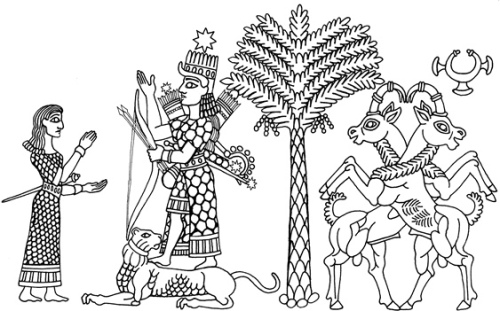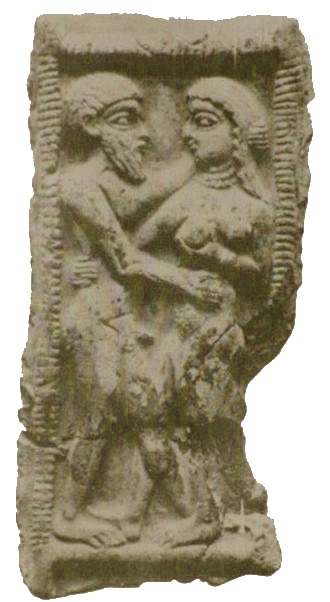Semiramis, Queen of Assyria
“But Istar was not merely the goddess of love. By the side of the amorous goddess there was also a warlike one. The Syrian goddess who migrated westward was a warrior as well as a bride. Among the Hittites and their disciples in Asia Minor, she was served not only by Galli, but by Amazons–warrior priestesses–as well.

Ishtar receives the worship of an Amazon. Ishtar stands on a lion, holding a bow with arrows at her back. Her eight-pointed star is atop her head.
The Artemis of Ephesos, her lineal descendant, was separated by a wide gulf from the Aphroditê of Cyprus. Both Artemis and Aphroditê were alike the offspring of the same Babylonian deity, but in making their way to Greece they had become separated and diverse. The goddess of the Hittites and of Asia Minor preserved mainly her fiercer side; the goddess of Phoenician Cyprus her gentler side. Both sides, however, had once been united in the Istar of Chaldea.
The Greek myths which recounted the story of Semiramis recorded the fact. For Semiramis is but Istar in another guise. As Istar was called “queen” by the Assyrians, so is Semiramis the queen of Assyria; as Semiramis deserts Menôn for Ninos or Nineveh, so did Istar desert her old haunts for her later temple at Nineveh.
The dove into which Semiramis was changed was the bird sacred to Istar. Her passion for her son Ninyas, “the Ninevite,” whom another version of the myth names Zames or Samas, is an echo of the passion of Istar, the Dav-kina of Eridu, for Tammuz the Sun-god. The warrior-queen of Assyria, in fact, was the great Babylonian goddess in her martial character.
While the gentler-mannered Babylonians preferred to dwell upon the softer side of Istar, the Assyrians, as was natural in the case of a military nation, saw in her mainly the goddess of war and battle. Like Babylonia, with its two centres of her worship at Erech and Accad, Assyria also had its two great sanctuaries of Istar at Nineveh and Arbela.
That she should have had no famous temple in Assur, the old capital of the kingdom, shows clearly the comparatively late development of her cult. Doubtless the earliest inhabitants of the Assyrian cities had brought with them the name and worship of Istar, but it could only have been long afterwards that it attained its final celebrity. Indeed, we can trace its progress through the historical inscriptions until it culminates in the reign of Assur-bani-pal.
There was a particular cause for this gradual development which was connected with the warlike attributes of the Assyrian Istar. The Assyrians were an essentially Semitic people. Their supreme goddess accordingly was that vague and colourless Bilit ili, “the mistress of the gods,” who sat as a queenly shadow by the side of Bel.
They had none of those associations with the older Accadian goddesses, with their specific names and functions, which the natives of the Babylonian cities possessed; apart from Istar, the evening star, there was no goddess among them who could claim a more independent position than that of a Bilit ili. Assur himself had no special consort, like Zarpanit at Babylon or even  at Accad.
Except Istar, therefore, the Assyrian pantheon was destitute of a goddess who could assert her equality with the gods.”
A.H. Sayce, Lectures on the Origin and Growth of Religion as Illustrated by the Religion of the Ancient Babylonians, 5th ed., London, 1898, pp. 270-2.

